#Staka
Explore tagged Tumblr posts
Text
Kretisches Kaffeetagebuch: Gramboussa Restaurant in Kaliviani
Als wir Kissamos durchqueren, lassen wir die zahlreichen Tavernen und Restaurants links, beziehungsweise rechts liegen. Nicht, weil wir etwa an deren Qualität zweifeln würden, sondern weil wir ein ganz besonderes Ziel im Auge haben: das Restaurant Gramboussa im nahen Kaliviani, von dem der Reiseführer “Glücksmomente auf Kreta” behauptet, es gehöre zu den besten Restaurants der Insel. Und nicht…
#coffeenewstom#Apaki#Coffeenewstom#Glücksmomente#Glücksmomente auf Kreta#Gramboussa#Gramoussa-Lamm#Griechenland#Kaliviani#Kreta#Kretische Küche#Kretisches Essen#Kretisches Kaffeetagebuch#Lamm in Blätterteig#Lamm mit Honig#Lamm mit Honigkruste#Maruva-Wein#Moschofilero-Weinblätter#Petimezi#Staka#Xilopites
0 notes
Text
8 rare local dishes from the Greek islands
Post inspired by this Greek article. I picked half of the dishes in order to create an island and local exclusive list, then translated and summarized the info. The pictures have links and in most of the respective websites you can find the recipes in Greek.
Makarunes with Sitaka, Kasos island
Makarunes is thick penne-like handmade pasta which is served with caramelised onions and the special Sitaka cheese of Kasos island. Sitaka is so rare, it is sometimes hard to find even in Athens but some restaurants do have this dish in their menu.

Atherinópita (Smelt pie), Syros island
It is not truly a pie, but it is a dish produced from frying various small fish like sand smelts and bogues as well as onions all close together until they create a crust holding them together.
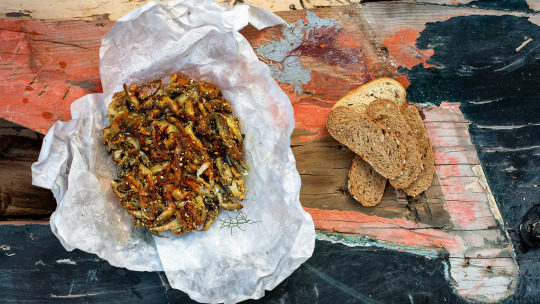
Photography: Χριστίνα Γεωργιάδου
Stuffed Hachles, Lesvos island
These are small baskets made of sun- and air-dried wheat kneaded with sour tarhana. They are usually stuffed with cheese, fresh tomato, herbs and spices but the filling is up to anyone's appetite really.

Sweet sefuklotí pie, Naxos and Tinos islands
Sefukloti or fesklopita is a rare pie that is actually a dessert, which is surprising (in Greek cuisine) because it looks exactly like a spinach pie. Sefukloti is a traditional recipe of these islands, particularly of the Catholics celebrating Christmas Eve (The Cyclades islands have the largest presence of Catholic Christians in Greece.) The pie is made of swiss chard, rice, sugar, molasses, walnuts, raisins, cinnamon and clove. The crust is kneaded with orange juice. Some also add onions and leeks, which also do not prevent this pie from working perfectly as a dessert. Before the serving, sefukloti is dressed with sesame seeds and honey.
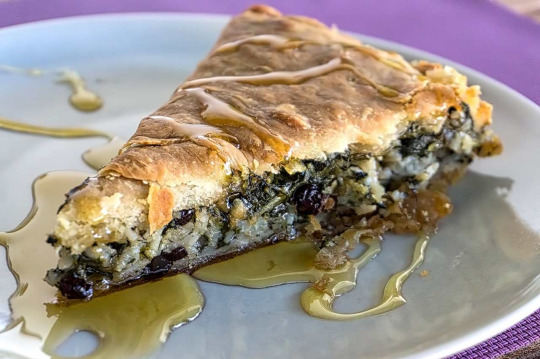
Anthógalo with eggs, Réthymnon, Crete island
Anthogalo or Staka is produced exclusively in Crete island. It is made of the salted fats of sheep milk. In this recipe, eggs are fried with anthogalo which works here like butter. The eggs are buttered by the anthogalo, while parts of it curdle and form cheese pieces during the frying.
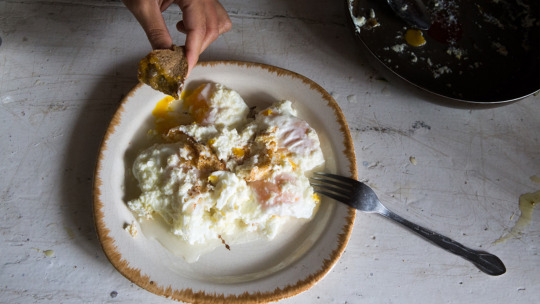
Aliaða & Vakalaópita, Cephalonia island
Aliaða is the local version of the Greek garlic dip "skorðaliá". Aliada is made of garlic, potatoes and the juices of boiled cod or octopus. The latter turns the dip a burgundy colour. Besides the famous fried cod that is enjoyed everywhere in Greece, in Cephalonia cod is also used to make "Vakalaópita”, a cod fish pie, in which the crust and the filling are kneaded with wine and vinegar.
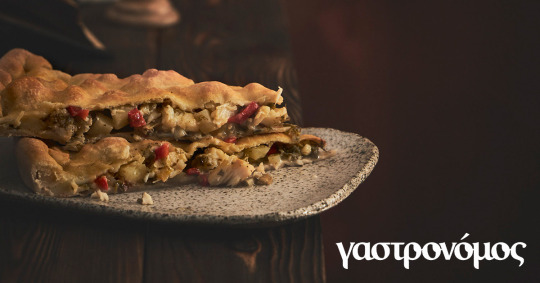
Rhodian pungiá, Rhodes island
These are wild greens pies baked in special local traditional pans. The wild greens are not boiled before they are added to the pie but they are salt dried. The juice that is produced by this process is mixed with olive oil and is used as a dressing for the pie when it's served.
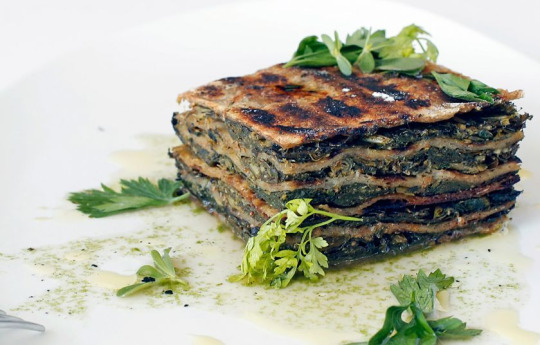
Anthos, Andros island
Anthos means flower. In Andros island it is also the name of the local spoon sweet, made of lemon flowers as well as the flowers of other citrus plants. It is fragrant, chewy and is considered an aristocratic dessert with limited production. It is a pretty hard recipe, because the flowers must be picked at the right time of the season and the cooking must be very careful so that the sweet won't get bitter and dark.

#greece#europe#cuisine#food#greek cuisine#mediterranean cuisine#cyclades#dodecanese#northeastern aegean#heptanese#greek islands#crete#kasos#syros#naxos#cephalonia#rhodes#andros#cycladic islands#ionian islands#kefalonia#rethymnon#rodos
166 notes
·
View notes
Text
Pokerating Day 17, Stakatakakatatakatakatakakataka

Charm: Honestly, while being a cool looking mon (gonna refer to the ultra beasts as pokemon for simplicity), it's also strangely cute when you realize its like... 100+ organisms in a trenchcoat. Each "brick" of the stakataka, sometimes jokingly called "taka" as I will be referring to them, is it's own organism. It's kind of like a coral when you really think about it. 10/10
Care: So, this is one of the least understood ultra beasts. We do not have documentation of it's ultra-space dimension. Anything here will be speculative, so ignore this rating if you only want cold hard facts. Stakataka is most reminiscent of a coral, as it is a colony of individual stone-shelled creatures. We can assume that each taka (brick) has a separate internal biology, so it would have to eat separately. This usually lends best to filter-feeding, buuuut stakataka has no real prey that it COULD filterfeed that we know of. It is likely, at least partially, carnivorous, as most similar creatures are, and I would theorize that they hunt other rock-types via ambush. This is an incredibly slow organism so it is NOT an active hunter. I would guess that one or two taka take watch while the others pretend to be a brick wall, and then they send a signal to ambush when something gets close. Overall I have to do a ?/10 though, since this is all speculative. A stakataka is also FUCKING MASSIVE. You're gonna need like several acres of land for it and LOTS of prey.
Safety: One taka is probably harmless but a full stakataka? No. 0/10
Utility: Field move data on these pokemon are... limited, to say the least. Both due to their discovery in Alola, a region that doesn't use field moves, and due to being exceedingly rare, we have no confirmation on what "HM" moves they could use. I would *guess* that it could learn cut, rock smash, strength, and MAYBE rock climb. Despite that, this fella(s) is (are?) essentially a mobile brick wall. You could easily set up a tarp over one and be safe if it likes you. ?/10 though regardless sadly.
Battle Potential: Damned by its type. Just like the many rock/steel types before it. I already went over this type not to long ago, but to simplify, double weak to fighting and ground, two of the most common offensive types, is damning. It's still alright, and if it can get going, setting up an iron defense or something so it can bodypress harder or setting trickroom, it can certianly put in work, but when other more common mons exist it's hard to justify. 4/10, I think it could do better in the future if a move or ability that makes trick room better is found, but right now it's just impressively slow.
Final Ratings:
Charm: 10/10
Care: Data Insufficient
Safety: 0/10
Utility: Data Insufficient
Battle Potential: 4/10
Final Notes:
Those totally legally obtained documents I got access to helped on this one but even those can only do so much. I love calling the little bricks "taka", in fact, if we said taka for each taka in a stakataka it'd look like staka....
TakatakatakatakatakatakatakatakatakatakaTakatakatakatakatakatakatakatakatakatakaTakatakatakatakatakatakatakatakatakatakaTakatakatakatakatakatakatakatakatakatakaTakatakatakatakatakatakatakatakatakatakaTakatakatakatakatakatakatakatakatakatakaTakatakatakatakatakatakatakatakatakatakaTakatakatakatakatakatakatakatakatakatakaTakatakatakatakatakatakatakatakatakatakaTakatakatakatakatakatakatakatakatakatakaTakatakatakatakatakatakatakatakatakatakaTakatakatakatakatakatakatakatakatakatakaTakatakatakatakatakatakatakatakatakatakaTakatakatakatakatakatakatakatakatakatakaTakatakatakatakatakatakatakatakatakataka
That almost looks like one with the T's I accidentally capitalized. Anyways its rumored to be roughly 150 takas per staka.
6 notes
·
View notes
Text
Can we please normalize not posting fanart on the most unknown and diabolical sites ever???
Use tumblr, twitter, TikTok, fuck even deviant art bro what I’m about to say YES it’s my fault I’m an idiot but dude I’m gonna lose it
I’m on safari priv browser and I’m looking for some TD pfps and junk, I know lame shit. So I’m srolling scroll scrolly scroll and I come across some cute Gwen fanart and I’m like aw. Nothing nsfw, just some cute art..
But the quality was shitty, so I click ‘visit’ expecting it to take me to yk deviant art ((since sometimes people post undevious stuff there) or tumblr and instead it doesn’t load the page and it takes me to something like staka whatever I was kinda zoned out, and then the Www changes to like ‘sexy change’ or something and I’m like uhm I shouldn’t be here!!!!
I’m like man it’s some stupid site nobodies heard of so it’s gonna be full of nsfw and gross shit and ADS and I start spamming the back arrow because I don’t need to art that bad bro so just as the back button registers my screen fucking flashes
‘Your iPhone has been hacked! Emergency action is needed!’ But the pop up disappeared because I clicked so fast I went all the way back to safari and now I’m freaked and I’m like bro if I show my mom she’s gonna be like what were u on?! And I’m gonna have to say somehow I ended up on sexychange or something?☹️ and then I’m like there’s no way I got hacked that fast right? So I searched it up and safari called me a moron and said your phone doesn’t send shit like that and the pop up is a scam or the hack itself or whatever
But basically I’m a moron and my phone is fine but like. Stop using these dog shit porn infested sites to post your art you losers I will update u guys if anything does happen with my phone but I doubt it
14 notes
·
View notes
Text
Names generated from American, French, German, Indian, Irish, Italian and Japanese forenames, including the letter sequence "Aka"
Aakara Aakatsuji Aakazuto Adasakatsuo Agaka Akaekke Akaff Akahaeld Akahi Akahnapo Akakarisuya Akakiyukith Akako Akakujit Akaliviedon Akamanta Akana Akanckyō Akanen Akanfrie Akanit Akanla Akann Akanneahi Akaolie Akara Akarla Akaru Akaryōki Akaríonne Akarō Akasachiko Akasaki Akasquene Akatada Akatakati Akataki Akateji Akater Akath Akathiko Akathna Akathne Akatichisa Akato Akatokio Akatsu Akatsukon Akatsumiko Akatsuna Akatsuni Akatsuo Akatsurie Akatsus Akattsu Akatty Akayosh Akayoshmi Akayuki Akayyancy Akazandsa Akaziamal Akazu Akazue Akazukenki Akazumia Akazumini Akazuo Akazushi Akazushirō Akazutz Akazuyasa Alakazuko Aliertakat Aliettaka Anfiakataty Antakathel Arakatsus Asaka Asakazueis Asakazun Athryakazu Atinobutaka...
Beanuaka Beryakayto Betsukaka Bettaka Brakazuel Bróisaka Caideaka Calakazu Carajeaka Chlaka Chtakatakio Coriakasako Coshōtaka Critakatin Daakaya Dakagla Dakazuelen Deoruaka Detaka Diakarli Dinnadaka Doaka Dolommakane Dorgakazio Duakao Duakatha Duakazu Dwaka Edemakato Edmuaka Eitaka Eleagayakaz Emitakazue Eshistakarō Essakazuri Estakath Etaka Etakah Etakazacki Feagessakar Feartakaz Felmusuakah Foruaka Futakae Fétakars Fétakatin Gakahirō Gakany Gakazuanemi Gasakaro Gemotaka Gerisakati Giaka Giakath Gresaka Gwendaakana Haineaka Harbentaka Heakanki Heallaka Heletaka Hewakayaj Hisaka Hissaka Hitakato Holmakazu Huakangemo Hubyraka Ichistakath Inaka Indritaka Isabhewaka Isakas Itakan Iwakazu Jaminetiaka Jeakat Jessakato Joaka Joakannina Joakar Joakatonn Joakatto Juakar Jun'yakazum Junakay Jūtakazurō Kaakarvio Kakaka Kakami Kakamichi Kakanfrihi Kakanne Kakaranka Kakath Kakatoshit Kakatsuth Kakazi Kakazuehi Kakazukei Kanpetaka Karuyaka Kataka Katakaisla Katakari Katakatsuke Katakaye Kathchitaka Katsusutaka Kazumisaka Kentakarim Kitakaziora Kriakayuko Kricantaka Kyōtaka Laffeakatia Lakanth Lakazuhi Letakayas Liakakatri Liakande Liakazumiko Lodhnakath Lodiakah Loriakako Luciakaga Maaka Maakazu Magaka Makaarler Makah Makahiríony Makantan Makar Makarolori Makarse Makata Makatako Makathéro Makatjanki Makatoishi Makatsuhi Makawna Makaya Makazuki Makazuyuki Makeyaka Mannetakag Maryūtakazu Masaka Masakasaco Masakazue Matakazunk Matakazuo Mauliltakah Meliaka Miakanluce Michtakazu Millentaka Mirearaka Mitakah Mitakann Mitakannied Moaka Moakatilly Muaka Mutaka Naakaji Nakag Nakane Nakazumi Natakarō Natakatsuko Netsuguaka Niquataka Nisteallaka Nitaka Nitakasa Norgiaka Otakazu Otheakatsu Pasakazuko Patakayas Paulaotakar Prakane Realiaka Realvataka Riakar Roaka Rolakaz Romitakay Rosakatsuy Rostaka Roxanaka Roxavasaka Ryaka Ryakazio Rylanaka Ryōtakae Ryōtakazu Ryūtaka Ryūtakazio Saaka Sakaganluc Sakah Sakaken Sakand Sakangert Sakanne Sakannie Sakanomh Sakaorge Sakarcey Sakasurie Sakatin Sakatsu Sakazio Sakazu Sakazuyuz Satrakasa Sentakazu Sertakazi Setakara Shiakateru Shikutaka Shkatakazu Shōyakazu Siroakarus Staka Strisakarō Susakath Sustetakara Suyakazu Sōtakaza Sōtakazuyo Takae Takaetta Takaga Takagael Takagaki Takagla Takagán Takah Takaherle Takahignal Takahio Takai Takaisad Takaittino Takakas Takakatsuhi Takake Takakiyoshi Takan Takanadhid Takanai Takanca Takanehin Takann Takannetere Takannie Takanored Takantz Takar Takara Takarah Takari Takaritad Takarlesa Takarlomura Takarnán Takaru Takaruna Takarō Takas Takata Takatald Takatav Takate Takatellian Takaterry Takatet Takatetaki Takathade Takathori Takatie Takatine Takato Takatsu Takatsue Takatsuhach Takatsuhiko Takatsuna Takatsuo Takatsuyana Takatsuyon Takavila Takay Takayasanki Takayn Takayuko Takazia Takazio Takazu Takazuke Takazuki Takazukio Takazuko Takazumichi Takazuna Takazunel Takazuo Takazutz Takaël Takitaka Talmotakazu Tanakatoyd Tatakar Telmasaaka Tiakakihirō Tin'yakamy Tochitaka Toilakazuo Tomitaka Tonandaaka Tromaka Téphnaryaka Uakari Uakath Ullrakayasu Utakazuken Uwentakato Valleettaka Valtakahan Vanetakazu Videtaka Wakaevasan Wakatsuyuki Walisakalip Yakakhbaphy Yakamita Yakanirtako Yakao Yakatsuna Yakatsurano Yakazu Yasaka Yasakazurō Yasakazush Yasayakari Yoakaya Yosakazuko Yoshōmakat Yōtaka Yūtaka Yūtakaill Yūtakarnán Yūtakaul Zaniettaka Ágakarenz Émeritakazu
5 notes
·
View notes
Text
Elizabeth Gowing’s and Robert Wilton’s book, ‘No Man’s Lands: Eight Extraordinary Women in Balkan History’ tells an absorbing story of women who fought for gender equality in the past - a struggle that’s far from won today.
It was random yet good timing that I received a review copy of No Man’s Lands: Eight Extraordinary Women in Balkan History, by Elizabeth Gowing and Robert Wilton, at the same time as I was finishing up an evaluation report related to efforts to promote women’s equality and political participation in the Western Balkans.
As I heard about contemporary female social and political activists talking about the increasingly hostile environment for female politicians in an age of social media trolling; about the retraditionalization and repatriarchalization trends accompanying the rise of far-right, illiberal socio-political trends; and the continued struggle to prevent gender-based violence, it was a welcome break to read about women who have been seeking to throw off the structures of social tradition and control.
However, reading about these women – viewed as “radicals” for their pursuit of human dignity and agency already back in the 19th century – was also a reminder that the social, political, cultural and economic changes required to underpin women’s equality are stunningly resistant to change, and susceptible to rollback.
This slender and readable volume would be of interest to specialists and non-specialists alike. Gowing’s expertise in travel writing and description is clear, and a book like this would fit well in a backpack of someone travelling through the region looking for interesting place and character descriptions and wanting to learn something about history and culture along the way. I initially found the selection of eight women to be quite random; however, once I accepted this, I realized the overarching connective tissue was not to be found in the country, background or expertise, but in the shared personality characteristics that pushed these women to go against the grain. The description of each woman profiled is inspirational.
Staka Skenderova is highlighted for her work in promoting girls’ education in Sarajevo in the mid-1800s; she opened the first school for girls well before others were later opened during Austro-Hungarian occupation. Her direct work with young people was complemented by her cultural contributions, such as the publication of Annals of Bosnia 1825-1856. Her dress, in men’s clothing, or as a nun, was an outward sign of her rejection of socially dictated femininity; “she smoked tobacco, went out to cafes and never married”, and her Sarajevan cosmopolitanism took her to Belgrade, Constantinople, and Jerusalem. The author, visiting her gravesite in Sarajevo, reflects on the relevance of her struggle in today’s stunted Bosnia: “Obliged to be ethnic first and educated second, Bosnia’s young women are discriminated against regardless of ethnicity.”
Marija Juric Zagorka broke ground as a journalist in Zagreb, editing and writing for Obzor, Zenski List and other periodicals, as well as writing novels and plays. She was imprisoned at one point for organizing demonstrations against Croatia’s Hungarian governor. Writing in favor of both Croatian identity and also women’s identity and independence, she suffered under the various political systems throughout her life. One compelling tidbit explains her practice of taking long walks in Zagreb but then later dictating her prose while blindfolded, conjuring the images she had had in her mind so they could be turned into text. She died close to poverty, though a memorial center in her old apartment remains as a testament to her life and work, as does the popular resonance and accessibility of her novels.
The chapter on Xenia (Ksenija) Petrovic-Njegos is intriguing, particularly for anyone who has a soft space in their heart for Montenegro’s former capital, Cetinje. The author tells her story while describing a visit to her former palace, explaining that being the first woman in the country to drive made it easier for her to pursue her passion for photography. Her photographs say as much about the photographer as the people being photographed, providing a view of her family members as well as fishermen and other “common” people. Illustrative of the author’s description of the hunt for factoids about the characters being studied, a woman working in a gift shop notes how Xenia was quite clever, evident “from the fact that she never got married”.
Maga Magazinovic, born in Uzice but living in Belgrade since a teen, is most famous for her contribution to dance (including a stint in Germany where she studied with none other than Isadora Duncan). However, she was also the first woman to graduate from the Faculty of Philosophy in Belgrade, wrote for Politike (the oldest daily still in circulation), and taught dance and the history of dance. The author’s description of attending a dance festival referencing Maga’s work and influence is evocative.
Margaret Hasluck is the only foreigner included in the collection. Her contribution was primarily through her book, The Unwritten Law in Albania, studying Albania’s kanun, published after her death. In this case, her status as an outsider was necessary as an Albanian woman in Albania at that time would not have been able to do so. Her expertise led to her recruitment by the British government to prepare special operations agents being sent into Albania during World War II. A trail of conversations leads the author to Elbasan to track down her house and any commemorative markings; the author concludes that the fact that her house is known to people yet unmarked in some ways reflects on the still important role of the oral tradition in that country.
The selection of Shote Galica as an example of a prominent woman from Kosovo is noted as fraught from the start. Galica and her husband had been village fighters during the decade spanning the Balkan Wars and World War I, and while documentary evidence of their lives is scant, a photo of them together holding pistols and rifles is one reference point for this nontraditional couple. The role of the Drenica valley in resistance back then and later in the 1990s is explained, providing useful historical context. This profile provides an opportunity to briefly explain various unique practices, such as the concept of the “sworn virgin”. While the author knows that some people regret that the most famous woman in Kosovo was essentially a “bandit,” others provide a more nuanced and charitable description. “Her name continues to represent the bravery and endurance of the Kosovan woman,” says one interlocutor.
Musine Kokalari, Albania’s most distinguished female writer, led a life in the 20th century that mirrored the arc of that country, for good and bad. She studied in Rome, and during World War II wrote three volumes of folktales. The fall of Albania’s monarchy and the Italian occupation would soon be eclipsed by Enver Hoxha’s paranoid and isolated Stalinist regime. She was among a group who in late 1945 drafted an appeal to the allies to postpone elections to enable time for some credible alternative to the communists. This was in vain; and she was arrested in early 1946, ultimately serving 16 years in prison. While she later wrote a secret account of her experiences and reflections, upon release from prison she lived in isolation.
The collection ends with Esma Redzepova – arguably the most popularly known and successful of the women profiled. Born in Skopje in 1943, she and her husband went on to enjoy a spectacular career performing traditional folk music that was accessible to and loved by people from throughout Yugoslavia, while at the same time elevating the music culture and tradition of the Roma minority from which she emerged.
The description of her performances of traditional songs will certainly lead the reader to YouTube to listen to them once again, or for the first time. In contrast to many of the other women whose lives were poor and marginalized (Skenderova at the end lived in poverty, and died after being hit by a horse and carriage in Ilidza; Kokalari was a street sweeper), Redzepova served on the Skopje City Council, represented Macedonia in Eurovision at age 69, and was a UN ambassador for refugees.
Certain themes come through across these multiple mini-biographies. There was an inevitable element of intersectionality lived by all of these women, as they dealt not only with the challenges of being a woman seeking more participation in the public and cultural space but also experienced various political challenges and regimes that spanned empires, fallen empires, wars, and various ascendant ideologies. While nationalisms – by their nature an expression of conservative and right-leaning ideology – sought freedom and independence for their nations, they often failed to seek to secure expanded rights for the women among that nation.
The role of marriage is interesting, for what is said or implied about the impact of marriage on women’s opportunities and options. Skenderova and Xenia never married; Zagorka’s marriage to a Hungarian official was a disaster she managed to escape; and Magazinovic’s marriage ended in divorce. Hasluck’s husband died when she was 35, after which she began her own adventures as a young widow. Galica’s husband had an additional wife, and perhaps even a third. Only Redzepova’s marriage – her husband was a composer and also her manager – seems to have been fulfilling.
And, perhaps of most interest to the traveler – whether armchair or traincar – the extent to which these women have been ignored, marginalized or nearly forgotten is conveyed. Gowing seeks out books, article references and public reminders, such as street names (Magazinovic), a statue to Zagorka in Zagreb, Hasluck’s house which had been turned into a kindergarten, a school named after Kokalari, and graves (Skenderova’s in Sarajevo). The search for these spaces provides color to the stories being told, as do references to elements of this journey – on the Bar-Belgrade train, or seeking information in Cetinje, or navigating the massive construction projects disrupting traffic and pedestrian flows in Tirana.
Specialists and social scientists could quibble with some of the characterizations, but overall it’s a reflective and sensitive book. You can often hear the voice of the narrator (for me it was always Elizabeth), which makes it substantially different than academic texts that are often dry and plodding.
Coming back to the present day and the challenges that women in the region (and globally) continue to face in fighting for equality and dignity, one can’t help but be reminded of the second-wave feminism saying: “The personal is political.” This was true for the women in this volume, and remains true today, in a time when growing insecurities creates opportunities for regressive political agendas. It is easy to be discouraged, but also easy to see that harnessing the power of 51 per cent (or more?) of the global population for a more just society could be the ultimate collective action problem. A reference to a Virginia Woolf quote is inspiring in this regard: “As a woman, I have no country. As a woman I want no country. As a woman my country is the whole world.”
12 notes
·
View notes
Text
I’m using my list of “imaginary species that I came up with for a school project that may or may not become a video game in the future”
Constantly anxious: Bubbles/Staka
obsessed with blood: Fumi
weird lesbian: ?
5 seconds away from hurting everyone: Soru/ Seronia
mascot: Bob
drawn/written: Bob in terms of drawing, Panni in terms of writing.
EVERY OC LIST GOT THA:
-constantly anxious who is 5 seconds away from a panic attack at all times -obsessed with blood -weird lesbian -5 seconds away from beating the shit out of everyone -the mascot -the one who's actually drawn/written about 99% of the time
10K notes
·
View notes
Link

Even those who know and love Greek Cuisine are surprised to discover the many uniquely Cretan food specialties. This largest of the Greek Islands has a distinctive cuisine all its own. Cretan food specialties are the elemental expression of the landscape itself- fragrant, wild, and delicious.
6 notes
·
View notes
Text
She got a staka hammer
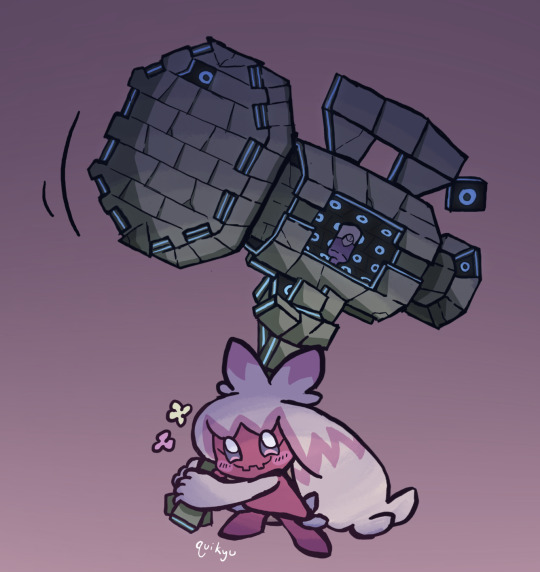
THIS IS MY HAMMER! HIS NAME IS MANUEL! YOU TWO ARE ABOUT TO BECOME VERY GOOD FRIENDS!
4K notes
·
View notes
Text

Serbs (Novica, Staka and Zorka) from Brgule, Bosnia and Herzegovina.
#serbs#serbian#traditional costume#brgule#sarajevo polje#slavic#balkan#eastern europe#bosnia and herzegovina
85 notes
·
View notes
Text
rromi (roma) names
Alabav Alili Ankal Anore Arbenika Arilaya Arona Ashon Asimiza Balaya Balia Baril Barila Barili Barril Bender Berkaka Berlen Berlin Berom Bertsho Besno Bessen Bessenda Bessimil Bethen Betivay Bevaldo Bidja Bidsh Bisha Bisopov Bobal Boboika Bobolda Boicu Boika Boiza Bolor Bottia Bublia Bublika Bublis Cabar Chaitsha Chaiyan Chaiyari Charila Chavo Chaya Chayala Chika Chilis Choma Choordji Choro Chuvo Coika Coiker Coizz Comozola Dajesmen Daroma Dikori Dilamiya Djawni Djorisha Dodor Domin Dooma Doorila Dorika Drika Drildo Dudji Dudjo Dukkeja Dukkel Dukkenda Dukkerli Dunaviya Dunina Dunisno Dunka Duntsaia Duntshey Duntsho Duram Durano Emanie Emilder Emirika Emitia Emmando Emmar Eshel Esmero Esnorel Ethen Ethero Etshaia Evali Fengo Fenso Fikano Fiken Floika Floiz Flosh Flouzsar Forilika Forka Framany Gariyaka Gemiya Gemmaia Gimer Gimerkli Gimerko Gimirvi Gimiya Gitawn Gitianka Gitsari Gitsh Graga Granusza Grasha Gromaiya Guarko Gunarila Gunka Guritsha Hebako Hengo Hershaya Hofon Homan Honsar Hoomaini Horiyak Horko Jawnia Jeshi Jesno Jetawna Jetsaiya Jetshako Jibbenda Jidilika Jivaya Jorka Jorom Kellcas Kinan Kinarb Kinka Kinkonso Kirellca Kirviol Kisha Kiskalda Krerko Kromaro Laeta Lashil Lashofra Lenia Lenno Lishavo Lishon Lisni Ludunka Lugem Luliko Lumenica Lumitsh Lutha Luthebar Luthero Lutsavo Lutzin Luvola Luvula Maiah Maiahne Maian Mairia Maitanka Maitia Maldaje Maldoren Maliawno Malilbre Maliza Manavi Manda Mandodo Manica Manie Manka Mantsho Mantsi Manuscha Marilaip Mengo Mereingo Merilor Merka Merko Milaver Milda Mildee Mimennie Mimer Mimiza Minka Mirambol Miranika Mirawni Mireinee Mirel Miridi Miringol Mitha Monsari Monsopoy Mutha Mutsa Mutsh Mutshi Mutshie Naiawnie Nankenda Narika Naviol Ninarri Nisli Nislika Nititha Oasimia Oasta Oramalia Orasha Orawnie Orawnin Oricha Orila Oriyaka Palda Palilila Palpanor Panka Pankarli Panoromi Panusza Papinar Papiso Pappin Pappisni Paprinel Papula Patinko Pativin Pativo Patri Patria Pattawno Pattoy Pattoya Pelly Penso Pethavi Piawni Pinarka Pisli Pitan Pitia Pitsh Pitshey Pitsurin Pittoko Pittoya Plaia Popolly Pulengan Puluthak Punarika Punie Puscha Pusza Puthay Putshaip Putshey Ragaro Ragarom Rambobo Ranka Rhaip Rhaitsh Rofriah Rufferi Rufferno Rumerla Rumilen Rupal Rupapi Rupati Saine Saria Sarri Shainan Shaitah Shako Shavi Shaviolo Shawni Sheba Sherlia Shikel Shila Shooma Shwan Sidjoro Simerica Simerka Singol Staka Stashi Staul Stavinka Stawnel Steklika Stersh Syeinavo Syeirawn Syeirvo Syerko Syero Takali Takoro Talika Talini Tandera Tanie Tankal Tanoro Tashaiya Tatoko Taule Tauli Tauluvo Taunaire Taunar Taunicu Taval Tawna Tawne Tawnel Tawni Tawnika Tawniol Tawniti Temali Teman Temandel Temia Temilen Temirvi Temiz Temmalpa Terenso Teril Terila Terili Terko Tersh Tershik Tertsho Tevado Tevol Tiawnie Tiggunie Titana Tivaya Tiviria Tobola Tobotia Triliz Trumil Trupana Tsavi Tshebar Tshelel Tshen Tsher Tshik Tshom Tsurani Tsurja Vandoro Vanichay Vayay Vedeli Verka Verko Verkonka Verkor Verli Veshika Vesmer Wennoro Wensopol Weshena Wesho Weshoom Wesnie Wesnoro Yakalda Yakorko Yaldan Yalia Yalin Yeini Yeiraga Yerina Yisaia Yishi Yisliz Yistia Yistitsa Yojor Yojori Yosha Yosharo Yoshilil Yoshompi Yottas Yulam Yulia Yuluvol Zigari Ziggur Zinar
1 note
·
View note
Text
singular staka
Quick question: What in Arceus' green Earth is this?

Found it half-buried in the snow a while ago.
2 notes
·
View notes
Text

Staka Oblt Böhner, 6./JG 53 on "Yellow 9" at Westerland AF at Sylt in July 1941. Here is Böhner again.
17 notes
·
View notes
Text
What I've learned on this trip:
- Greece is fucking hot, Kratos needs props for living in Greece and then living in a place so cold.
- I get checked out more in other countries than I do my own.. why am I ugly to people near me but hot to people who live mileeeeees away, sucks.
- The greek language is basically impossible to just try to read with no prior learning
- the greek like their cheese.
- this is the second time I've gone on holiday and forgot my book and both times I've been furious with myself
- I like Staka, Gyros and Yoghurt with Honey
- I should do a follow forever because i love some of you guys and I dont show it enough
- lotta doggos over here
9 notes
·
View notes
Text
He ataka my staka till I get a beast boost.
His az on my marill till I’m feelin ill
His plume may be vile but to me they gotta sweet scent
I’m so good at this
I’m like weirdly good at that joke where you take a word and make it sound like an inuendo. Like the she beefin on my stroganoff kinda jokes. I’ve got a poets soul I can do it with any Pokémon name ever
5 notes
·
View notes
Note
"Ahahaha! So you do have a crush, do you? You really ARE a dork, Staka-taka. I won't get offended by you not wanting help on this! Just a little thought, y'know?"

He pauses hearing his sister’s nickname for him.
“Yeah, I... I’m a big dork. I know. I appreciate the offer for help, though.”
1 note
·
View note